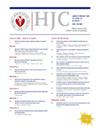INFLA 评分:鉴别心包炎的新诊断范式。
IF 3
3区 医学
Q2 CARDIAC & CARDIOVASCULAR SYSTEMS
引用次数: 0
摘要
背景:心包炎的诊断可能具有挑战性,因为并非所有患者都符合常规标准。被忽视的诊断意味着症状持续时间更长,复发风险更高。C 反应蛋白(CRP)被广泛用作炎症标志物,但它也有一些局限性。本研究旨在评估 INFLA 评分(一种评估低级别炎症的有效指标)在明确诊断心包炎方面的实用性和预后价值:方法:纳入疑似心包炎患者。INFLA-评分根据白细胞和血小板计数、中性粒细胞与淋巴细胞比值、CRP计算得出,范围为-16至+16。主要终点是 INFLA 评分与常规标准心包炎诊断的相关性。结果:共纳入 202 名患者,年龄(47±17)岁,女性占 57%。在 72 例(36%)确诊为心包炎的患者中,86%(vs.36%, p0)的患者 INFLA 评分大于 0(HR 8.48,95%CI 3.39-21.21),与 CRP(HR 1.72,95%CI 3.39-21.20)相比,具有 86% 的敏感性和 64% 的特异性。INFLA-评分阳性(37% vs. 8%,P0,敏感性86%,阴性LR=0.22)或规则诊断(INFLA-评分≥10,特异性97%,阳性LR=13)的患者在6个月后复发心包炎的频率更高:INFLA-评分是评估心包炎可能性的有用诊断工具,对进一步复发有很强的预后价值,优于CRP。本文章由计算机程序翻译,如有差异,请以英文原文为准。


INFLA-score: A new diagnostic paradigm to identify pericarditis
Background
Diagnosis of pericarditis may be challenging because not all patients meet the conventional criteria. An overlooked diagnosis implies a longer course of symptoms and an increased risk of recurrences. C-reactive protein (CRP), widely used as an inflammation marker, has some limitations. This study aimed to assess the usefulness and prognostic value of INFLA-score, a validated index assessing low-grade inflammation, in the definite diagnosis of pericarditis.
Methods
Patients with suspected pericarditis were included. The INFLA-score was computed based on white blood cells and platelet count, neutrophil-to-lymphocyte ratio, and CRP, ranging from −16 to +16. An INFLA-score > 0 was considered positive for the presence of pericardial inflammation. The primary end point was the association of INFLA-score with diagnosis of pericarditis according to conventional criteria. The recurrence of pericarditis at 6 months was the secondary end point.
Results
A total of 202 patients were included, aged 47 ± 17 years, and 57% were females. Among 72 (36%) patients with a diagnosis of pericarditis, an INFLA-score > 0 was observed in 86% (vs. 36%, p < 0.001), abnormal CRP in 42% (vs. 10%, p < 0.001), pericardial effusion in 44% (vs. 19%, p < 0.001), abnormal electrocardiogram in 56% (vs. 24%, p < 0.001), and rubs in 5% (vs. 0.1%, p = 0.072). INFLA-score > 0 had the strongest predictive value for the diagnosis of pericarditis (hazard ratio 8.48, 95% confidence interval [CI] 3.39–21.21), with 86% sensitivity and 64% specificity, as opposed to CRP (hazard ratio 1.72, non-significant 95% CI 0.69–4.29). Recurrent pericarditis at 6 months was more frequent in patients with a positive INFLA-score (37% vs. 8%, p < 0.001, rate ratio 4.15, 95% CI 2.81–6.12). In patients with normal CRP, INFLA-score–confirmed ongoing inflammation in 78% of the cases. Compared with the conventional criteria, the INFLA-score had the highest accuracy (area under the curve = 0.82). Different cutoffs were valuable to rule out (INFLA-score > 0, sensitivity 86%, and negative likelihood ratio 0.22) or rule in (INFLA-score ≥ 10, specificity 97%, and positive likelihood ratio 13) the diagnosis.
Conclusions
The INFLA-score is a useful diagnostic tool to assess the probability of pericarditis, with a strong prognostic value for further recurrences, outperforming CRP.
求助全文
通过发布文献求助,成功后即可免费获取论文全文。
去求助
来源期刊

Hellenic Journal of Cardiology
CARDIAC & CARDIOVASCULAR SYSTEMS-
CiteScore
4.90
自引率
7.30%
发文量
86
审稿时长
56 days
期刊介绍:
The Hellenic Journal of Cardiology (International Edition, ISSN 1109-9666) is the official journal of the Hellenic Society of Cardiology and aims to publish high-quality articles on all aspects of cardiovascular medicine. A primary goal is to publish in each issue a number of original articles related to clinical and basic research. Many of these will be accompanied by invited editorial comments.
Hot topics, such as molecular cardiology, and innovative cardiac imaging and electrophysiological mapping techniques, will appear frequently in the journal in the form of invited expert articles or special reports. The Editorial Committee also attaches great importance to subjects related to continuing medical education, the implementation of guidelines and cost effectiveness in cardiology.
 求助内容:
求助内容: 应助结果提醒方式:
应助结果提醒方式:


